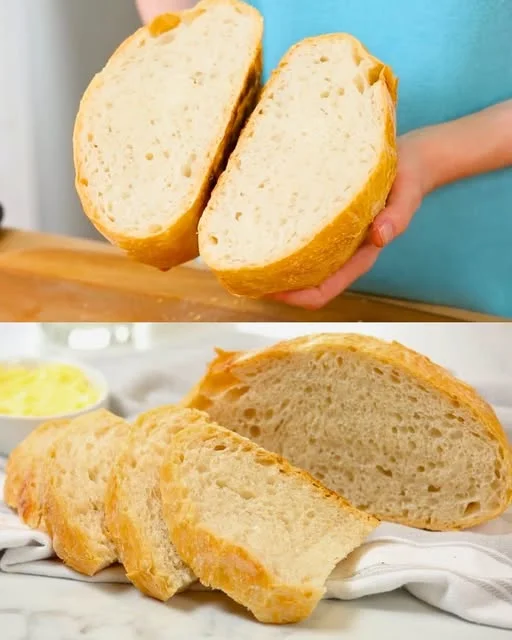The smell of freshly baked bread wafting through the kitchen is one of the most comforting aromas in the world. It brings back memories of childhood, of watching my grandmother knead dough with practiced hands, humming softly as she worked. I would stand on a stool beside her, eagerly waiting for my turn to shape the dough, feeling the soft elasticity between my fingers.
There was something magical about the process—the transformation of simple ingredients into a golden, crusty loaf that filled the house with warmth. When the bread came out of the oven, we could hardly wait for it to cool before tearing off a piece, steam rising as we spread butter over its soft, pillowy interior.
As I grew older, I realized that making bread is more than just baking—it is an experience, a ritual that connects generations. It is a reminder of how something as basic as flour, water, and yeast can create something so nourishing and satisfying. Now, whenever I bake this bread, I carry those memories with me, and I hope this recipe brings the same warmth to your kitchen.
Why You Should Make Homemade Bread
There are plenty of store-bought breads available, but nothing compares to the taste and texture of homemade bread. Here’s why making your own is worth it:
- No preservatives or additives – Unlike commercial bread, this recipe uses only natural ingredients.
- Fresh, warm, and aromatic – Nothing beats the experience of pulling a loaf straight from the oven.
- Cost-effective – A homemade loaf costs far less than artisanal bread from a bakery.
- Simple ingredients – Made with pantry staples, this bread is easy to prepare anytime.
- Better texture and flavor – You control the ingredients, ensuring the perfect balance of softness and chewiness.
- Versatile – Enjoy it fresh, toasted, as a sandwich, or alongside soups and stews.
Homemade bread is not just food—it is an experience that brings comfort and joy.
Ingredients
| Ingredient | Quantity |
|---|---|
| Dry active yeast | 1/2 teaspoon |
| Warm water | 1 cup |
| Sugar | 1 teaspoon |
| All-purpose flour | 3 cups |
| Salt | 1 1/2 teaspoons |
Directions
- Activate the yeast – In a small bowl, dissolve yeast and sugar in warm water. Let it sit for 5–10 minutes until frothy.
- Mix the dough – In a large bowl, combine flour and salt. Slowly add the yeast mixture and mix until a dough forms.
- Knead – Transfer the dough to a floured surface and knead for 8–10 minutes until smooth and elastic.
- First rise – Place the dough in a greased bowl, cover, and let it rise in a warm place for 1–1.5 hours, or until doubled in size.
- Shape the dough – Punch down the dough, shape it into a loaf, and place it in a greased loaf pan.
- Second rise – Cover and let it rise again for 30–40 minutes.
- Bake – Preheat oven to 375°F (190°C). Bake for 25–30 minutes until golden brown and hollow-sounding when tapped.
- Cool and serve – Let the bread cool before slicing for the best texture.
Nutritional Information (Per Slice, Approx.)
| Nutrient | Amount |
|---|---|
| Calories | 150 kcal |
| Protein | 4 g |
| Fat | 0.5 g |
| Carbohydrates | 30 g |
| Fiber | 1 g |
| Sodium | 300 mg |
Tips for the Best Homemade Bread
Even though this recipe is simple, a few key techniques will ensure your bread turns out perfect every time.
1. Activate the Yeast Properly
Yeast is a living organism, and it needs the right conditions to thrive. Always dissolve it in warm (not hot) water, around 100-110°F (37-43°C). If the water is too hot, it will kill the yeast. Let it sit until it becomes frothy and bubbly—this means the yeast is active and ready to work.
2. Measure Ingredients Accurately
Too much flour can result in dense, dry bread, while too little can make it too sticky. For best results, use a kitchen scale to measure ingredients precisely.
3. Knead the Dough Well
Kneading develops the gluten in the flour, which gives the bread its structure and chewiness. Knead for 8–10 minutes until the dough is smooth and elastic. If you press a finger into the dough and it springs back, it is ready.
4. Give the Dough Enough Time to Rise
Patience is key. The first rise should take about 1 to 1.5 hours, allowing the dough to double in size. This develops the best texture and flavor. If your kitchen is cold, place the dough in a warm spot, such as near the oven or in a slightly warmed microwave.
5. Shape the Dough Correctly
Once risen, punch down the dough gently to release air bubbles, then shape it into a loaf. Be careful not to over-handle the dough, as this can deflate it.
6. Let the Bread Rise Again Before Baking
The second rise is crucial for getting a light, airy loaf. Let the shaped dough rest for 30–40 minutes before baking to ensure a good rise in the oven.
7. Bake at the Right Temperature
A steady 375°F (190°C) creates a golden crust while keeping the inside soft. To check for doneness, tap the bottom of the loaf—it should sound hollow.
8. Let the Bread Cool Before Slicing
As tempting as it is to cut into the bread immediately, allow it to cool for at least 15–20 minutes. This helps set the structure and prevents it from becoming gummy.
How to Customize This Bread
This basic bread recipe is incredibly versatile. Here are some ways to add variety:
1. Herb and Garlic Bread
- Add 1 teaspoon of dried rosemary, thyme, or oregano to the dough.
- Mix minced garlic into the dough for extra flavor.
2. Honey Wheat Bread
- Replace 1 cup of all-purpose flour with whole wheat flour.
- Add 2 tablespoons of honey for a touch of sweetness.
3. Cheese Bread
- Mix in 1/2 cup of shredded cheddar or Parmesan for a rich, cheesy loaf.
4. Seeded Bread
- Sprinkle sesame seeds, sunflower seeds, or flaxseeds on top before baking for extra crunch and nutrition.
5. Cinnamon Swirl Bread
- Roll the dough with a cinnamon-sugar mixture before shaping for a sweet variation.
With these variations, you can enjoy a different homemade bread every time.
Storing and Freezing Homemade Bread
Room Temperature Storage
- Store in a bread box or airtight container at room temperature for up to 3 days.
- Avoid refrigerating, as it can dry out the bread.
Freezing
- Wrap the loaf tightly in plastic wrap, then place it in a freezer bag.
- Freeze for up to 3 months.
- To thaw, leave it at room temperature for a few hours or warm in the oven at 300°F (150°C) for 10 minutes.
Reheating Tips
- Toast slices for a crispy texture.
- Warm in the oven at 325°F (165°C) for 5–7 minutes to refresh.
Proper storage ensures your homemade bread stays fresh and delicious.
Frequently Asked Questions
1. Can I use instant yeast instead of active dry yeast?
Yes! Use the same amount of instant yeast, but skip the proofing step and mix it directly with the flour.
2. What if my dough doesn’t rise?
- Check if your yeast is expired or if the water was too hot or too cold.
- Let the dough rise in a warm, draft-free spot.
3. How can I make my bread softer?
Adding 1 tablespoon of butter or oil to the dough can help create a softer texture.
4. Can I make this bread without sugar?
Yes, but sugar helps activate the yeast and improve the texture. If omitting sugar, allow extra time for the dough to rise.
5. What is the best way to slice homemade bread?
Use a serrated knife and cut with a gentle sawing motion to avoid squishing the loaf.
Final Thoughts – A Simple Recipe with Endless Possibilities
Homemade bread is more than just a recipe—it is a tradition, a comfort, and a way to bring people together. Whether you are new to bread-making or an experienced baker, this simple recipe delivers soft, fluffy, and perfectly golden loaves every time.
Once you taste the warmth and freshness of a homemade loaf, you may never go back to store-bought bread again. So the next time you crave something wholesome and delicious, take a little time to knead, rise, and bake. The result is always worth it.

Soft and Fluffy Homemade Bread – A Timeless Recipe for Every Kitchen
Ingredients
Method
- In a small bowl, dissolve yeast and sugar in warm water. Let it sit for 5–10 minutes until frothy.
- In a large mixing bowl, combine flour and salt. Slowly add the yeast mixture and stir until a dough forms.
- Transfer the dough to a floured surface and knead for 8–10 minutes until smooth and elastic.
- Place the dough in a greased bowl, cover, and let it rise in a warm place for 1–1.5 hours or until doubled in size.
- Punch down the dough, shape it into a loaf, and place it in a greased loaf pan. Cover and let it rise again for 30–40 minutes.
- Preheat the oven to 375°F (190°C) and bake for 25–30 minutes until golden brown and hollow-sounding when tapped.
- Let the bread cool before slicing.
Notes
- Use lukewarm water (100–110°F) to properly activate the yeast.
- For a softer crust, brush the loaf with melted butter after baking.
- Store in an airtight container for up to 3 days or freeze for up to 3 months.
- This bread is great for sandwiches, toast, or dipping into soups and stews.

